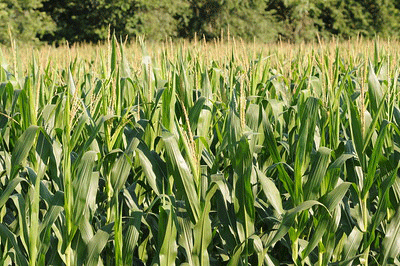(Sept. 25, 2024) Featured in Farm & Ranch Plains Edition: The adoption of no-tillage farming increased water use efficiency and allowed for cropping intensification, especially in semi-arid environments like western Kansas.
Agriculture and Natural Resources News
Control annual weeds with fall-applied herbicides ahead of corn and sorghumWith row crop harvest well underway, it is time to start planning fall herbicide applications. Herbicide applications in late October through November can improve control of difficult winter annual weeds. Fall weed control is associated with warmer soils and easier planting in the spring. However, it is important to remember that fall-applied herbicides may limit your crop options in the spring. Also, remember that herbicides should not be applied to frozen ground. Get the full story in the K-State Agronomy eUpdate. |
K-State Specialists to Present at 5 States Beef ConferenceThe 5 States Beef Conference will return this fall with two sessions featuring beef industry updates from university specialists across the region, including two Kansas State University researchers. The conference begins Tuesday, Oct. 14, at the Beaver County Fair Building in Beaver, Oklahoma, and continues Wednesday, Oct. 15, at Frank Phillips College Rahll Campus in Dalhart, Texas. The program is designed for cow-calf, stocker, and feedlot operators and will cover timely issues affecting beef production in the High Plains. Learn more about the 5-State Beef Conference here. |
|
Get control of fall-emerged marestail before next springMarestail or horseweed (Erigeron canadensis) is a challenging weed to manage in no-till or minimum-till soybeans systems. This weed is classified as a winter annual, but it germinates well into spring and summer, making it even more difficult to manage. In addition to an extended germination window, marestail can produce up to 200,000 seeds/plant, with approximately 80% of those seeds being able to germinate immediately after maturation. Kansas producers also face the added difficulty of trying to manage glyphosate-and ALS-resistant marestail. (Figure 1). Get the full story in the K-State Agronomy eUpdate. |
Resistant weeds pose challenge in long-term no-tillage systemsNo till allowed for greater soil water storage with more crop residue kept on the soil surface. With more residue retained in no-till systems, wind and water erosion are reduced, and more organic matter accumulates in soil. Read the rest of the story on Farm & Ranch Plains Edition. |
Agriculture Today:1776 - Getting Ready to Wean...Deadly Prussic Acid(September 27, 2024)- Sandy Johnson, K-State beef specialist, and John Holman, K-State cropping systems and forage agronomist, continue the show with reminders about prussic acid and the dangers it has for livestock. Listen to Ag Today. |
Considerations when planting wheat into dry soilDespite some recent rainfall events, the most recent Drought Monitor shows 96% of Kansas still experiencing abnormally dry or worse conditions. (Figure 1). Topsoil conditions are getting drier in many areas of Kansas, particularly in northwest and north central Kansas (Figure 2). Unfortunately, the precipitation outlook is not very favorable (Figure 3). For wheat yet to be planted in these areas, producers are left with a few options. Get the full story in the K-State Agronomy eUpdate. |
Control annual weeds with fall-applied herbicides ahead of corn and sorghumWith row crop harvest well underway, it is time to start planning fall herbicide applications. Herbicide applications in late October through November can improve control of difficult winter annual weeds. Fall weed control is associated with warmer soils and easier planting in the spring. However, it is important to remember that fall-applied herbicides may limit your crop options in the spring. Also, remember that herbicides should not be applied to frozen ground. Read the full story in the K-State Agronomy eUpdate. |
Get control of fall-emerged marestail before next springMarestail or horseweed (Erigeron canadensis) is a challenging weed to manage in no-till or minimum-till soybeans systems. This weed is classified as a winter annual, but it germinates well into spring and summer, making it even more difficult to manage. In addition to an extended germination window, marestail can produce up to 200,000 seeds/plant, with approximately 80% of those seeds being able to germinate immediately after maturation. Kansas producers also face the added difficulty of trying to manage glyphosate-and ALS-resistant marestail. (Figure 1). Read the full story in the K-State Agronomy eUpdate. |
Musk thistle control in the fallMusk thistle (Carduus nutans) is one of 12 noxious weeds in Kansas, infesting over 420,000 acres. It has been reported in nearly every county in Kansas (Figure 1) and is found primarily in pastures, rangeland, hay meadows, alfalfa, fallow, roadsides, and waste areas. Under the new Noxious Weed Law (March 2021), musk thistle is considered a Category C weed. That means it is well established within the state and has an extensive population. Read the full story in the K-State Agronomy eUpdate. |
Feedlot Facts: Starting Newly Weaned Calves(K-State Beef Tips Newsletter) by Justin Waggoner - One of the greatest challenges cattle producers often experience during weaning is getting newly weaned calves to consume feed in bunk. Unfortunately, successfully addressing this challenge is essential to success. Simply stated, |
Wheat planting: Tips for good stand establishmentRegardless of the soil moisture conditions at wheat planting time, producers can take a few important steps to improve their chances of getting a good stand of wheat. Read the full story in the K-State Agronomy eUpdate. |
|
A recent eUpdate article from early September discussed the best time for the last cuttings of alfalfa ahead of the winter months (https://eupdate.agronomy.ksu.edu/article/alfalfa-management-deciding-on-the-last-cutting-this-fall-607-4). The decision should be weather-based at this time of the year because the timing of the last two cuttings impacts the winter survival and productivity of the stand in the following year. Read the full story in the K-State Agronomy eUpdate. |
Marketing Calves(K-State Beef Tips Newsletter) by Justin Waggoner - It’s time to start thinking about our management and marketing strategies for this year’s spring calf crop. Margins in the cattle industry and agriculture are often unfortunately narrow (even with projections of record-setting high calf prices). Therefore, I would offer that maximizing calf revenue is important for cow/calf producers every year. Calf revenue from my academic perspective is driven by 3 factors, 1.) the number of calves sold, 2.) sale weight of calves and 3.) price received. Read the full story in the K-State Beef Tips Newsletter. |
Why are some cornfields left to dry out?TOPEKA (KSNT) — Corn farmers are collecting their harvest as summer transitions to fall — but some fields are looking a little more brown than green. Lucas Haag with the Kansas State University Research & Extension Office told Nexstar’s KSNT that some farmers have let their cornfields dry out purposefully before harvest. Multiple factors go into the harvesting process that help farmers decide when it’s time to collect their crops, including the variety of corn they planted. Read the full story on KHAN 2 |
Small grain forage options for this fallPasture productivity has been reduced in the past two years, and forage supplies have been greatly reduced due to dry weather. In 2022, conditions tended to be worse in western KS, and in 2023, eastern KS suffered drought. Looking at 2024, 95% of the state is abnormally dry again. Some regions of the state have had two years of very dry conditions. Filling the forage needs outside summer grazing can be challenging even in normal years. This challenge is even greater when summer pasture productivity is reduced and forage supplies are low. Small grain forages planted in the fall or spring can provide a profitable forage option for producers. Cool season forages, especially in the vegetative stage, are high in crude protein and energy. Forages can be terminated in early spring, allowing time to plant a summer row crop if soil moisture is adequate. Read the full story in the K-State Agronomy eUpdate. |
Harvest aid application decisions in cottonThe use of harvest aid products is a common practice in cotton production in the U.S. Cotton Belt to prepare the crop for harvest and optimize lint yield and fiber quality. Harvest aid categories include boll openers, defoliants, desiccants, and regrowth inhibitors. Read the full story in the K-State Agronomy eUpdate. |
Test forages to prevent nitrate and prussic acid poisoningMany Kansas cattle operations rely on some type of harvested feed to use in the winter months, and common among those sources are forage sorghum, millets, sorghum-sudangrass, and sudan. Forages in the sorghum family are prone to two different problems when feeding cattle: nitrate poisoning and prussic acid (hydrocyanic acid, HCN) poisoning. Millet (proso and pearl) do not contain prussic acid but can have nitrates. Prussic acid and nitrate poisoning are easy to confuse because both result in a lack of oxygen availability to the animal and are more likely to occur when the plant is stressed (fertility, hail, drought). Read the full story in the K-State Agronomy eUpdate. |
Emergency measures to control wind erosionCropland can be quite susceptible to wind erosion under some conditions. Drought conditions may limit vegetative growth and cover. Burning or removing crop residues for forage creates a particularly serious hazard. Winter wheat and other fall-planted crop fields may also be susceptible during periods of low cover before crop establishment after planting. This is particularly true during drought (Figure 1). Marginally productive cropland may not produce sufficient residue to protect against wind erosion. In addition, overgrazed or poorly vegetated rangeland may also be subject to wind erosion. Read the full story in the K-State Agronomy eUpdate. |
Grasshoppers are abundant in many areas of KansasIt is well understood that weather patterns can have a significant impact on grasshopper populations year to year. Warm, dry weather increases the survival of nymphs and adult grasshoppers, leading to increased egg production during the growing season, while cool, wet weather promotes fungal pathogens that can reduce egg and nymph survival. The abundance of grasshoppers being observed now is likely due to the weather patterns of the last couple seasons. Another factor influencing grasshopper populations is an abundance of food, especially broadleaf weeds. A diet high in these forbs leads to greater nymph survival, faster growth, larger adult grasshoppers, and increased egg production. Despite many areas still being impacted by some level of drought, sporadic rainfall over the growing season has helped weeds persist in many areas of the state, which has likely contributed to the noticeable number and diversity of grasshoppers currently being observed. As these weedy sources of food are exhausted or controlled, grasshoppers may shift their grazing over to anything still growing in the landscape. In areas with greater grasshopper pressure, seedling alfalfa and wheat could be at risk. Read the full story in the K-State Agronomy eUpdate. |
Wheat planting: Be cautious of planting too earlyThe general target date for planting wheat for optimum grain yields in Kansas is within a week of the best pest management planting date, or BPMP (formerly known as the “Hessian fly-free”) date (Figure 1). If forage production is the primary goal, earlier planting (mid-September) can increase forage yield. However, if grain yield is the primary goal, then waiting until the BPMP date to start planting is the best approach (Figure 2). Planting in mid-September is ideal for dual-purpose wheat systems where forage yields need to be maximized while reducing the effects of early planting on reduced grain yields. Read the full story in the K-State Agronomy eUpdate. |
In-furrow fertilizers for wheat productionWheat is considered a highly responsive crop to band-applied fertilizers, particularly phosphorus (P). Application of P as a starter fertilizer can be an effective method for part or all the P needs. Wheat plants typically show a significant increase in fall tillers (Figure 1) and better root development with the use of starter fertilizer (P and N). Winterkill can also be reduced with the use of starter fertilizers, particularly in low P testing soils. Read the full story in the K-State Agronomy eUpdate. |
Update on fall armyworms in KansasFall armyworm, Spodoptera frugiperda (Figure 1), is known to feed on over 80 host plants. In Kansas, it can damage several important crops, pasture, turf, and home landscaping. This insect does not overwinter in Kansas. Rather, it is native to the tropical regions of the western hemisphere and is active year-round along the Gulf Coast and southern Florida, migrating in from these locations each year. Two full generations are possible in Kansas, with defoliation and grain damage being the biggest concerns. Read the full story in the K-State Agronomy eUpdate. |
Alfalfa management: Deciding on the last cutting this fallAlfalfa will quit growing after the first hard freeze (when temperatures reach below 26°F), which in Kansas occurs on average around October 15 but can be as early as October 1 or as late as November 1. The decision should be weather-based at this time of the year because the timing of the last two cuttings impacts the winter survival and productivity of the stand in the following year. Read the full story in the K-State Agronomy eUpdate. |
Low levels of corn stunt disease have been confirmed in KansasCorn stunt disease and its associated vector, the corn leafhopper (Dalbulus maidis), have been recently confirmed in Kansas. To our knowledge, this is the first detection of the disease in Kansas, and it came shortly after the disease was first reported in Oklahoma and Missouri. Corn stunt disease and associated symptoms have been confirmed in Sedgewick, Pratt, Stafford, and Edwards Counties in field corn and Riley County in sweet corn (Figure 1). Recent scouting efforts across Kansas confirm active leaf hoppers in many additional counties in Central and Southwest Kansas. Disease incidence was low overall, and most corn is reaching later stages of maturity. Read the full story in the K-State Agronomy eUpdate. |
Conduct soil bioassays to determine herbicide carryover potentialMany factors can influence herbicide degradation, namely precipitation and temperature. But, regardless of the environmental conditions, herbicides require time to break down in the soil. When drought, hail, or other situations change crop rotation plans, it can result in concerns about herbicide injury due to inadequate time for a potentially injurious herbicide to break down. A bioassay is one of the simplest things to do to determine the potential for herbicide residues to injure a subsequent crop. A bioassay is an easy at-home test to see how your seeds will grow in the field soil. There are three steps to conducting a bioassay. Read the full story in the K-State Agronomy eUpdate. |
K-State survey of cotton grower perspectivesIn 2020, southern Kansas farmers planted 195,000 acres of cotton, which produced 300,000 480-lb bales of cotton lint and 99,000 tons of cottonseed, with a combined economic value of $97,164,000! Cotton has established a place in Kansas, and K-State Research & Extension wants to hear from our cotton growers to better understand the current status of cotton production and emerging challenges in cotton production in Kansas. Read the full story in the K-State Agronomy eUpdate. |
|
Nitrate toxicity in drought-stressed foragesDrought-stressed crops like sorghum, millet, and corn can accumulate high nitrate levels, posing serious risks to livestock. Proper testing and management of these forages are crucial to prevent nitrate toxicity. Learn more about best practices for forage testing and harvesting in this detailed K-State Agronomy eUpdate article. For additional information, refer to the K-State Research and Extension publication “Nitrate Toxicity”. |
K-State: Grazing cover crops benefits soil health in dryland systemsJuly 8, 2024—Discover how Kansas State University researchers are revolutionizing sustainable farming in the central Great Plains! Their latest study reveals that grazing cover crops can significantly improve soil health in no-till dryland cropping systems, addressing key concerns for producers in water-limited environments. Conducted over three years across multiple fields in Kansas, this research highlights how integrating livestock into cropping systems not only avoids negative impacts on soil properties but also boosts soil organic carbon and potassium levels. Dive into the findings and learn how this innovative approach can enhance both agricultural productivity and environmental sustainability. Read the full story at KSRE News. |
Grain Market Insights with Dan O'BrienLink to original Ag Today Podcast |
CAMPBELL: Identifying Chinch Bugs and False Chinch BugsJune 29, 2024—Chinch bugs in Kansas are a persistent threat to various types of grass, affecting everything from turf farms to golf courses. According to K-State Extension Entomologist Jeff Whitworth, these pests primarily target sorghum, but can also pose problems for corn and wheat. With the current surge in chinch bug activity in central and west central Kansas, it's crucial to differentiate between chinch bugs (Blissus leucopterus) and false chinch bugs (Nysius sp.). Anthony Zukoff, a K-State Extension Entomologist at the Southwest Research-Extension Center, emphasizes the importance of accurate identification for effective management strategies. Read more about Anthony’s insights on identifying these pests. |
Thrips in grain sorghumJ.P. Michaud, K-State Entomologist at the Agricultural Research Center in Hays, has reported an unusual surge in thrips activity on sorghum plants in Ellis County. Despite their tiny size, these insects have caused noticeable cosmetic damage. Alongside this, there's also been an increase in chinch bug pressure, which could pose a threat to crops. For detailed insights and recommendations from J.P. Michaud, read more. |
This K-State Agronomy eUpdate article, focuses on developing effective long-term control strategies for this troublesome weed that impacts Kansas farmers. Read the full eUpdate article. |
|
Tank-mixing herbicides and agrichemicals is essential for effective weed control, but it can also increase the risk of physical incompatibility. This article provides an overview of tank-mix order principles for herbicide applications and emphasizes the importance of following product labels and conducting jar tests. For more detailed guidance and tips, check out the full article. |
|
|
|
|
Herbicide applications and higher temperaturesWarmer temperatures are in the forecast for the latter part of June across Kansas. For July, the Climate Prediction Center is calling for an increased probability of warmer-than-normal temperatures statewide. If you are planning herbicide applications, here are some things to consider when applying herbicides during hot weather. Read the full story in the K-State Agronomy eUpdate. |
World of Weeds - TumblegrassTumblegrass, a native perennial grass that can be problematic in no-till fields, and learn how to distinguish it from similar species. Learn more in this K-State Agronomy eUpdate. |
Controlling weeds after wheat harvestThe 2024 wheat harvest is well underway, so it is time to think about weed control in wheat stubble. Weeds that have been suppressed by the canopy will grow rapidly once crop competition is removed. In addition, weeds that have emerged through the wheat canopy will be damaged during harvest and will quickly begin regrowth. Delaying control can result in lost soil moisture that could be used for crop production, as well as weed seed production which will cause difficulties in the future. Read the complete K-State Agronomy eUpdate story. |
Palmer amaranth control in grain sorghumWhen the aggressive nature of Palmer amaranth is combined with the limited post-emergence herbicide options in grain sorghum, problems often arise – even when an adequate preemergence herbicide program is used. This article covers post-emergence herbicide options for Palmer amaranth control in grain sorghum. |
2024 Kansas Wheat Plot Tours - Updated ScheduleMay 30, 2024 (Featuerd in the K-State Agronomy eUpdate.) - The Department of Agronomy and K-State Research and Extension will host several winter wheat variety plot tours in different regions of the state. Make plans to attend a plot tour near you to see and learn about the newest available and upcoming wheat varieties, their agronomics, and their disease reactions. |
May 29, 2024 (Featured on Farms.com) - Soybean gall midge, a new pest to soybean production in the United States, has been found in two northeast Kansas counties. Kansas State University entomologist Anthony Zukoff, Southwest Research-Extension Associate said the pest causes devastating damage to fields. “After several years of Nebraska counties on the Kansas line having infestations, soybean gall midge finally showed up in northeast Kansas -- in Nemaha and Marshall counties -- last year,” Zukoff said. |
May 24, 2024 (Featured in the K-State Agronomy eUpdate.) Corn rootworm degree day accumulation in Kansas is ahead of last year in the northern half of the state, with egg hatching expected to begin in one to two weeks. In the southern half, egg hatching is already underway, with peak hatch likely in two to three weeks. For more details and management recommendations, visit the K-State Agronomy eUpdate. |
|
In many areas of Kansas, prolonged drought has resulted in short wheat and thin stands. Harvesting wheat in these situations can be a challenge. Special attention needs to be given to cutting height, machine adjustments, and operator control. In short wheat, getting the heads into the combine with less straw will be challenging. |
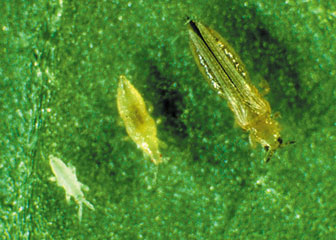
May 16, 2024 (Featured in the K-State Agronomy eUpdate.) - Kansas cotton growers escape most of the damaging insects found deeper in the Cotton Belt. However, as cotton acres continue to rise in the state, producers and consultants must be aware of insect pests with the potential to cause significant yield loss in this crop. |
May 9, 2024 (Featured in the K-State Agronomy eUpdate.) - The Soybean Gall Midge (Resseliella maxima) was first observed in Nebraska in 2011 but was not officially described as a new species until 2018 when this tiny fly established itself as an emerging pest of soybeans in South Dakota, Nebraska, Minnesota, and Iowa. New infestations have been documented every year since and its range has expanded into Missouri. Soybean gall midge has been documented in Nebraska along the Kansas border as recently as 2021. This pest should be actively scouted for during the growing season, especially in counties along the Nebraska border. |
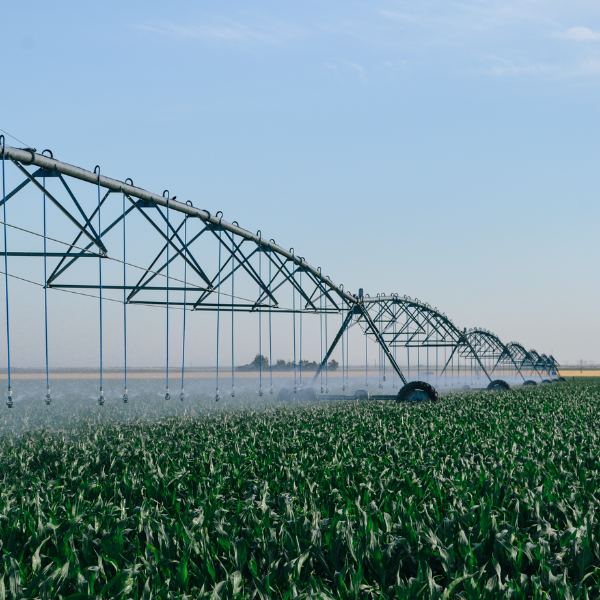
Ensuring Quality Forage: A Comprehensive Guide to Sampling for Farmers and Ranchers in Western KansasFor farmers and ranchers in Western Kansas, ensuring forage quality is crucial for successful operations. Kansas State Research and Extension (KSRE) provides valuable publications to assist in every stage of forage production, including "Forage Sampling Procedures and Equipment" (MF3177) by John Slocombe and Lyle Lomas, which offers essential insights into effective forage sampling. |
How Does Western Ragweed Impact Pasture Production? |
White grub damage in brome fieldsApril 18, 2024 (Featured in the K-State Agronomy eUpdate.) - White grubs, the larvae of beetles commonly known as May beetles and June beetles, can be pests of many different commodities. Dead patches in brome fields in Kansas have recently been reported (Figure 1). The sizes of the dead patches varied across affected fields, but in all cases, white grubs could easily be found in soil when collecting samples from the areas (Figure 2). This strongly indicates that the white grubs are responsible for the observed dead zones. |
Soil temperature, weather forecast, and seed quality are critical for cotton establishmentApril 18, 2024 (Featured in the K-State Agronomy eUpdate.) - Cotton can overcome many stresses and produce profitable lint yields when the crop gets off to a good, uniform start. So, when is the “best” time to plant cotton to meet those criteria? In a thermally-limited environment for cotton, such as Kansas, we know we need to plant as early as possible to maximize yield potential. However, those extra heat units from early planting are only useful if you have a stand of plants to benefit. |
Several K-State publications on insect pest management updated for 2024April 11, 2024 (Featured in the K-State Agronomy eUpdate.) -Several K-State Research and Extension publications related to insect management in Kansas were recently updated and are available to the public. These publications were prepared to help producers manage insect populations using the best available methods proven practical under Kansas conditions. They are revised annually and intended for use during the current calendar year. The user should know that pesticide label directions and restrictions are subject to change, and some may have changed since the publication date. |
K-State Technology Development Institute partners with agronomy department on ammonia studyApril 1, 2024—Kansas State University's Technology Development Institute (TDI) and agronomy department have partnered to enhance farmers' profitability by reducing nitrogen losses through innovative sampling devices. TDI optimized the design and created 3D-printed parts for passive samplers that measure nitrogen losses due to ammonia volatilization after fertilizer applications. Research indicates that up to 30% of nitrogen fertilizer can be lost to the atmosphere, and this project, funded by the Foundation for Food and Agriculture Research, aims to minimize these losses. By using advanced micrometeorological methods, the K-State team, led by Lucas Haag, Dorivar Ruiz Diaz, Eduardo Santos, and Peter Tomlinson, is conducting statewide measurements to improve nitrogen application methods and timing. Read the full story on Farms.com. |
|
Researching efficient nitrogen managementEfficient nitrogen management is essential for reducing greenhouse gas emissions and the detrimental effects of overapplication. Kansas State University has been awarded a $872,560 Seeding Solutions grant by the Foundation for Food & Agriculture Research (FFAR) to enhance nitrogen management practices for Great Plains producers. With additional support from the Kansas Fertilizer Research Fund and the United Sorghum Checkoff Program, the total investment reaches $1,745,125. This research aims to provide crucial regional data on nitrogen losses and climate-smart agriculture practices, focusing on water-limited grain sorghum production in central and western Kansas. Read the full story on Farm Progress. |
March 14, 2024 (Featured in the K-State Agronomy eUpdate.) - A recent fact sheet titled “Managing Spring Planted Cover Crops for Livestock Grazing under Dryland Conditions in the High Plains Region,” produced in collaboration with K-State, Colorado State University, and the University of Nebraska, offers comprehensive guidelines for optimizing cover crops for livestock grazing. It details best practices for species selection, stocking rate adjustments, and effective grazing management to maximize forage productivity and soil health. For the complete guide, visit the K-State Agronomy eUpdate or view the publication. |
Central Kansas Forage Update - March 21March 7, 2024 (Featured in the K-State Agronomy eUpdate.) - All are invited to attend a rapid-fire forage update sponsored by the Kansas Forage and Grassland Council in conjunction with the Mid-America Farm Expo on March 21 from 9:00 a.m. to noon. The update will feature a hay market review, tips for managing woody encroachment and Old-World Bluestem on rangeland, and a focus on non-traditional forage alternatives and annual legumes to use as part of your overall forage program. Our group of forage experts will also hang around to answer your rangeland and forage questions at the end. |
Start monitoring alfalfa weevils using degree days and scoutingMarch 14, 2024 (Featured in the K-State Agronomy eUpdate.) - Degree day accumulations for Kansas alfalfa weevils are well ahead of normal for the entire state this year (Table 1). A similar trend occurred in 2023. There were reports of treatable infestations in south-central Kansas during the last week of March, and in mid-April of 2023, fields were being treated, or close to being treated, in the central, southeast, and northeast regions of the state. It is recommended that scouting for weevil activity should be occurring right now in all regions of the state. |
Don't miss the last K-State CropTalk webinar on March 12March 7, 2024 (Featured in the K-State Agronomy eUpdate) - The popular K-State Crop Talk webinar series started on February 20, 2024. This year, CropTalk is focused on agronomic topics for producers across the western half of Kansas. Topics include management for wheat production, biological products concerning soil fertility, high pH soils, and fallow replacement options in dryland systems. Continuing education credits will be offered, with one credit for each session. |
|
FFAR Grant Provides Data on Nitrogen Management Practices in the Great PlainsFebruary 20, 2024—Efficient nitrogen management is crucial for reducing greenhouse gas emissions and the environmental impact of overapplication. Kansas State University received a $872,560 Seeding Solutions grant from the Foundation for Food & Agriculture Research (FFAR) to study nitrogen management practices in the Great Plains. With additional funds from the Kansas Fertilizer Research Fund and the United Sorghum Checkoff Program, the total investment in this project is $1,745,125. This research aims to provide regional data on nitrogen losses and climate-smart agriculture practices, particularly for water-limited grain sorghum production in central and western Kansas. Read the full story at Foundation for Food & Agriculture website.
|
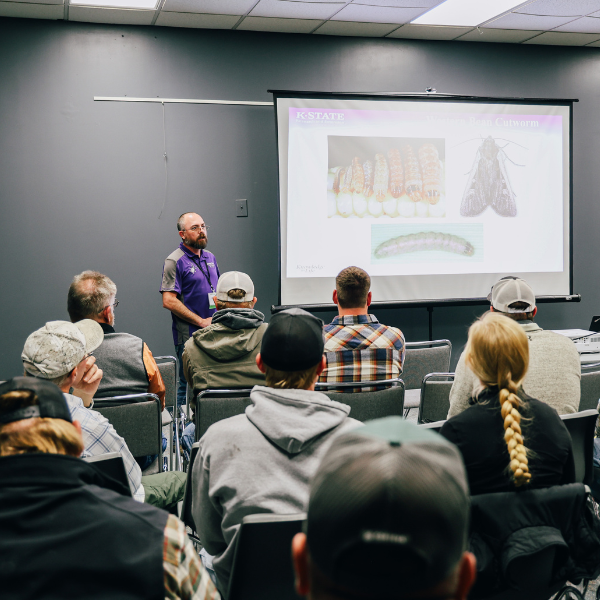
Cover Your Acres Winter Conference, January 16-17January 4 & 11, 2024 (Featured in the K-State Agronomy eUpdate.) - K-State Research and Extension will host the 21st annual Cover Your Acres Winter Conference for crop producers and consultants on January 16 and 17. The conference will take place in the traditional in-person format at the Gateway Civic Center in Oberlin, KS. |
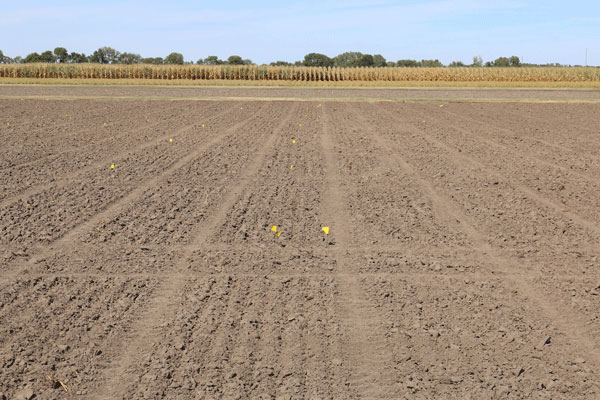 Considerations when planting wheat into dry soil
Considerations when planting wheat into dry soil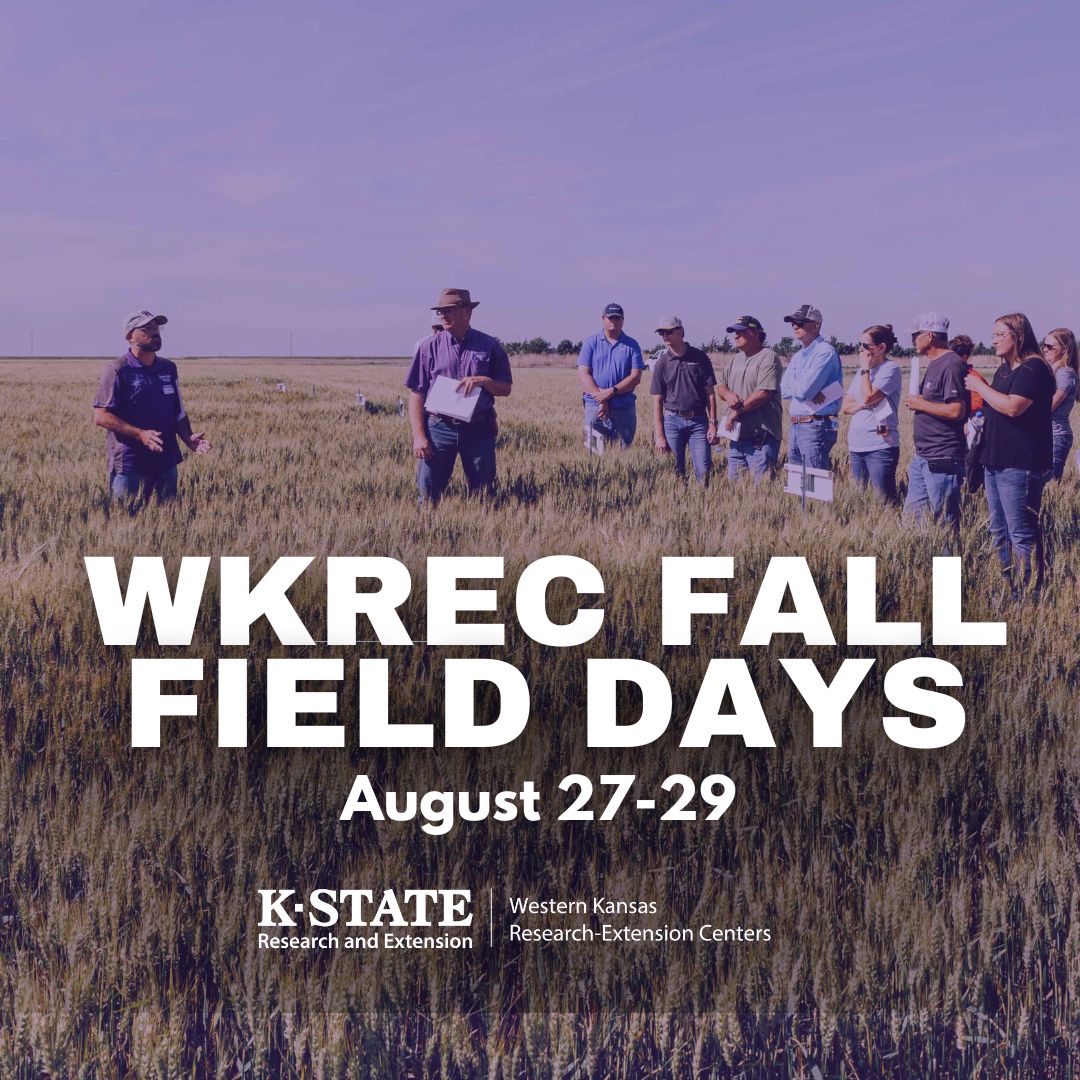 Western Kansas Fall Field Days are set for three locations in August
Western Kansas Fall Field Days are set for three locations in August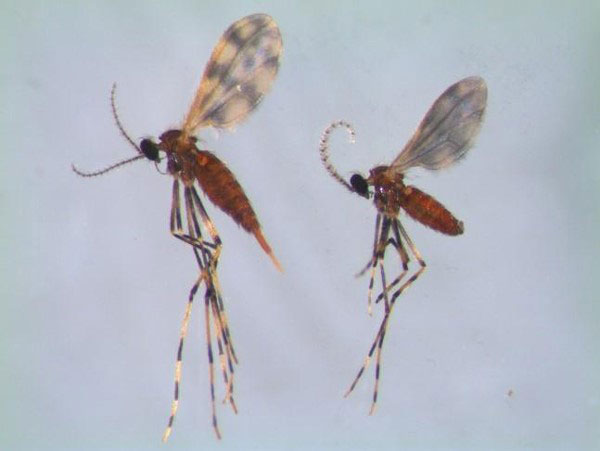 Soybean Gall Midge Shows Up in Two Kansas Counties
Soybean Gall Midge Shows Up in Two Kansas Counties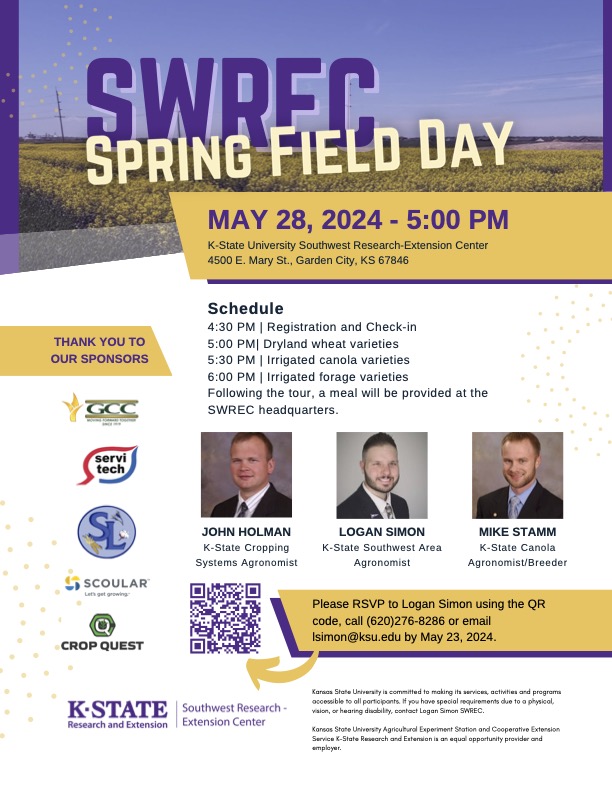 K-State Southwest Research and Extension Spring Field Day - May 28
K-State Southwest Research and Extension Spring Field Day - May 28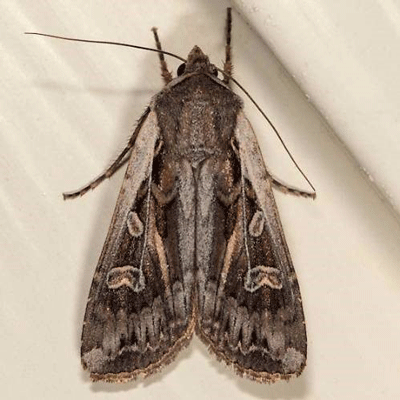
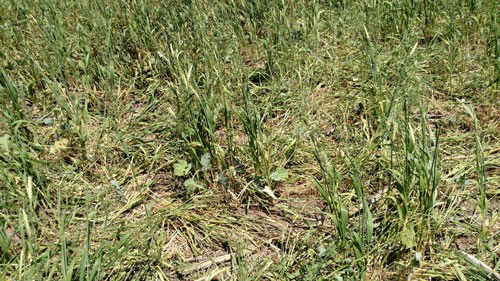 Managing spring-planted cover crops for grazing
Managing spring-planted cover crops for grazing